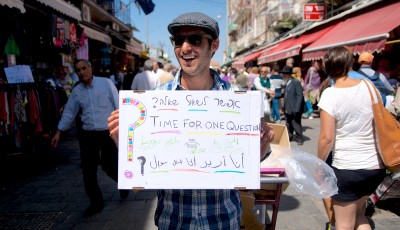I think all of my friends are amazing people. But every now and then, some friends do such incredible work that you just want to shout about it from the highest mountaintop. But absent a mountaintop, profiling them in your magazine is the next best thing. Joseph Shamash and Andrew Lustig are two of those friends, and their and Jeff Handel’s One Wish Project is such an incredible work. What began as three friends talking to strangers on the streets of Jerusalem about wishes has grown into a global project dedicated to building bridges between people one face at a time. I caught up with Joseph to discuss the release of their newest video,”One Wish Skid Row,” and how they hope to bring the One Wish model to campus in the wake of their upcoming college tour.
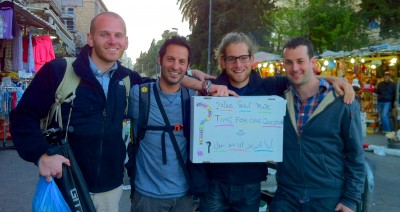
- What is the One Wish Project and how did it start?
One Wish Project (OWP) began in April, 2013 with a camera, a cardboard box with a simple question (written in English, Hebrew, and Arabic), and a desire to give voice to everyday people living in Jerusalem. Our goal was to mirror the shared humanity of individuals living in one of the most seemingly “conflicted” areas in the world. We produced “One Wish Jerusalem” in fewer than 3 days and within a week of launching on YouTube, we had almost 100,000 views— as well as extensive media coverage in Haaretz, The Times of Israel, Upworthy, The Huffington Post, The Forward, Yediot Ahronot, and The Daily Beast. We realized we were onto something big. With the inauguration of Iranian President Hassan Rouhani in August 2013, we set out to make our second film, “One Wish for Iran, Love Israel.”
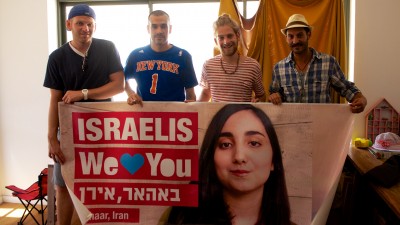
With so much of the mainstream media emphasizing the tension between Israel and Iran, we went to Tel Aviv, Jerusalem, and Bethlehem to ask Israelis and Palestinians their “one wish for the incoming president and the Iranian people.” We were truly surprised at how positive everyone’s wish was, emphasizing the need for renewed relations, peace between both countries, and a simple desire to “have coffee” together. Our second film also received extensive media coverage and over 100,000 YouTube views, and we were even featured on Israeli news channel i24.
When we moved back to Los Angeles in late 2013, we realized the need to humanize marginalized individuals through filmmaking, and set out to speak to the homeless on Skid Row in downtown Los Angeles. We released our third film on August 13, 2014 and we hope to spread the message of our shared humanity once again through the wishes and advice of the homeless.
One Wish Project recently completed a PresenTense LA Fellowship for 2014, an 8-month joint program with the Jewish Federation of Los Angeles that provides social entrepreneurship training, leadership skills, business tools, mentoring, and more to kick start our idea into a successful venture.
Beyond the worldwide exposure of our three films, we are currently building the educational component of our organization by engaging students and people of all walks of life by using our films as a launch pad to further the dialogue. We have had the pleasure of speaking at conferences, in houses of worship, schools, camps and universities, and are continuing to grow every day.
- What is your ultimate goal for the organization?
To create a more unified world by producing films, educational content and interactive events that highlight our shared humanity.
- Have you noticed any greater change come about as a result of these videos? New friendships or initiatives between Jews and Arabs or Iranians? Has there been any backlash?
No backlash other than some comments on our YouTube page. Most people who communicate with us are inspired by the film and the message of the people. We’ve been fortunate to showcase the film in conflict resolution situations as a conversations starter, in places like Olive Tree Initiative at UCLA or American Jewish University.
What we’d like to create are partnerships and relationships with other communities not only in Israel and United States, but also all around the world. Our hope is to bridge conflict by sharing stories and use the films to talk about the current situation.
- What inspired you to shift the focus back home and make the Skid Row video?
When we moved back to LA, we wanted to tackle a pressing issue other than the conflict in the Middle-East. When we looked at our mission to give a voice to those who are marginalized, the very first group we thought of was the homeless.
Personally, I’ve always been fascinated by Skid Row ever since I stumbled upon it in my early 20’s. It’s a place I always take tourists to see because of how vast and seemingly hopeless it is. Yet every time I go there, I encounter someone who touches my life. Each person on the streets has a story. Some are addicts, some have mental health issues, some have been to jail, but there’s always a humanizing story when you stop and listen to what they have to say and what has brought them to live on the streets. It overwhelms me with gratitude for the little things in life that we forget to appreciate everyday. A warm shower, a roof over my head, a comfortable mattress, you name it. Most importantly, so many of the people we’ve encountered lack support. It really hits home how important community is and that there are people who can help you when times get tough and can help you up when you’ve fallen.
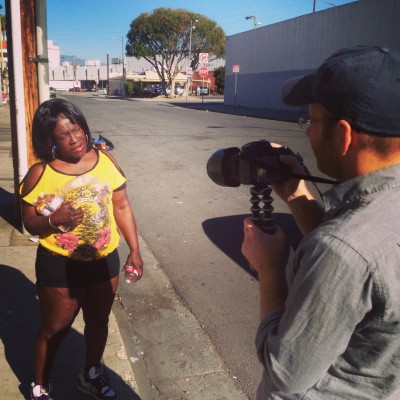
- I noticed that in this video, there are fewer people sharing wishes than in your previous ones. Was that intentional, or were these people less willing to share wishes? In either case, why?
In the process of filmmaking, sometimes a person’s wish is very powerful and sometimes what they do in front of the camera is more compelling and tells a greater story. In all our films, we seek to show the reality on the ground and give a voice to those who are marginalized as best as we can and share compelling stories that are inspiring, thought-provoking, emotional, and controversial.
For “One Wish Skid Row,” we asked 2 questions: a “wish” and a piece of advice. Sometimes the conversations ended there. Sometimes we spoke with them for upwards of 45 minutes and put the most interesting parts of the conversation in the film. The goal however for everyone one of them is to humanize the people we encounter, I think we’re 3 for 3 so far.
- What do you want to accomplish by bringing the videos to campus?
Films are just the starting point. We aim to use the films as the conversation starter to teach about important social issues and values. Students are our target audience and the people we want to empower most to change the world and change ourselves within. Additionally, we want to see the world changed by action, so we are creating a platform and space for others to share their stories, wishes, photos and more with us and take action to make the world around them a little more connected.
- Do you think the One Wish concept has the potential to work on campus, perhaps bringing together students on opposite ends of the Israel/Palestine or other heated campus conflicts?
Absolutely. A big part of peace building work is to act and DO something together. Don’t talk about politics but have some underlining event that gets people on opposite sides of the spectrum together to build something. The conversations and relationships build organically. The stereotypes die out and the opportunity for REALationsips and long-lasting change becomes possible.
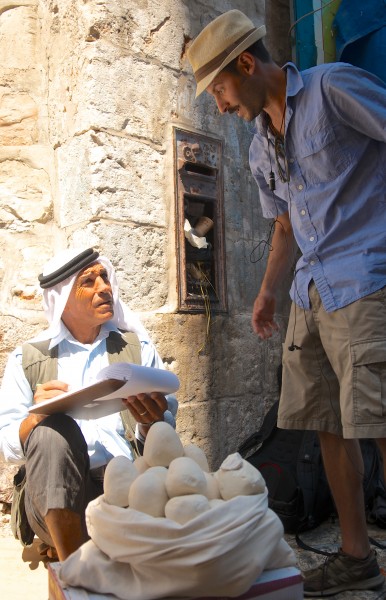
- What is it about wishes, do you think, that makes this project so powerful?
Everyone has a wish! it’s amazing to see grown-up adults become almost childlike when you give them the opportunity to dream and hope again, like they were when they were in 2nd grade!
Further, the question is an incredible conversation starter. It allows the person being interviewed to let their guard down and just talk to us like we didn’t have a camera pointing right at them. As a filmmaker that’s incredibly important if you want to be able to really hear what’s on the person’s mind and in their heart.
- If you had one wish, what would it be?
Great question. It’s the same since the first film. That all of us overcome our fears and live up to our potential every day.
- How do we make wishes come true?
It’s very simple but it requires a lot of work: Small changes make big differences when done together in community. Imagine a comet traveling at 100,000 m.p.h., if you change the angle of flight just slightly, the destination and flight path of the comet changes drastically.
Same thing for our project, if we can inspire 100,000 people to make one small change in their lives and do one thing for the homeless, we’re making a huge impact on the world. And that’s making wishes come true!
